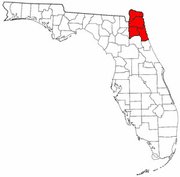First Coast
|
|
The First Coast is a region of the U.S. state of Florida. It extends south along the east coast of the state from the Georgia state line to the southern end of Anastasia Island. So named for the city of St. Augustine, the oldest city in the United States. Encompassing Nassau, Duval, Clay, St. Johns, and Flagler Counties, principal cities include Jacksonville, Fernandina Beach, Orange Park, Jacksonville Beach, Palm Coast and St. Augustine. The geography is coastal plain with low hills along the bluffs of the Saint Johns River. Trail ridge, an ancient seashore, borders the western boundary of the First Coast and separates the region from the Okefenokee Swamp.
History
The history of the First Coast can be traced over 12,000 years to the Timucuan Indians, who originally settled the area. Modern settlement can be dated back to 1564 when René Goulaine de Laudonnière founded the French Colony of Ft. Caroline near the mouth of the St. Johns River, close to modern day Jacksonville. On August 28, 1565, Pedro Menéndez de Avilés, founded the city of St. Augustine. After defeating the French in skirmishes around the area, Spain had firmly established the area as Spanish territory.
The Spanish era would continue until 1763, when Spain gave control of Florida to England. During English Rule, most of the Spanish population left the area along with the remaining native population. After the end of the Revolutionary War in 1783, England ceded Florida back to Spain, beginning the second period of Spanish rule. During this time, many settlers relocated to the First Coast from the United States. The town of Cowford, now Jacksonville was settled in 1791.
In 1819, the United States signed the Adams-Onís Treaty with Spain. This treaty gave all of Spanish Florida to the United States for $5 million.
American settlement of the First Coast expanded rapidly following the purchase. The city of Jacksonville was formally established in 1832, with many of the cities along the First Coast tracing their founding to this period. The Civil War brought minor actions to the First Coast. After Florida's secession on January 10, 1861, most of the region was retaken by Union Forces early in war. By mid-1862 most of the First Coast was in Union hands, and would remain throughout the end of the war.
After the war, more people would begin to settle along the coast. Brought to the area by the beaches and warm weather, the coast remained a tourist destination through the end of the 19th century. The construction of Henry Flagler's railroad to Miami saw a decline in the tourist industry, however, some cities remained popular destination, and do so to this day. Amelia Island and St. Augustine continued to draw visitors to the First Coast for their beaches and historic settlements.

